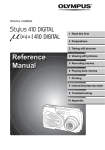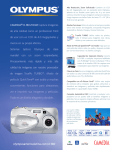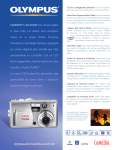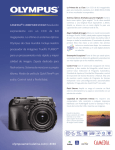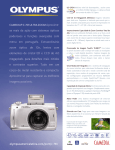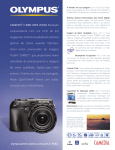Download Olympus Digital Camera USB Storage Class User's Manual
Transcript
TWO CORPORATE CENTER DRIVE MELVILLE, NY 11747-3157 DIGITAL TECHNICAL SUPPORT CONSUMER PRODUCTS GROUP (888) 553-4448 DOCUMENT NUMBER 2739 HOW TO DOWNLOAD PICTURES USING AN OLYMPUS USB AUTO CONNECT CAMERA Introduction USB Auto Connect, also known as “USB Storage Class”, is a feature that allows an Olympus digital camera to emulate a disk drive when connected to a computer. This feature makes it simple to copy the pictures to your computer by using standard “drag-and-drop” procedures. There is no need to install drivers (except for Windows 98) since the camera is supported by the operating system. Installing the USB Driver for Windows 98 NOTE: A USB driver only needs to be installed if the computer is running Windows 98/98 SE. Once the driver is installed, you will not need to perform this procedure again. 1) Connect the camera to the USB port of the computer using the provided USB cable. 2) Turn the camera ON (For the E-10 camera turn the mode dial to Setup/Connection mode. For other digital cameras with a mode dial, choose any selection. For an Olympus digital camera that has a front lens cover, open the cover.) 3) The "Add New Hardware Wizard" should automatically run. Click <Next>. 4) Make sure “Search Optimum Driver for Device in Use (Recommended)” is selected, and then click <Next>. 5) Open your CD-ROM drive door and place the Olympus Utility CD into the tray. Press and hold down the <Right-shift> key on the keyboard while pressing the CD tray close button. 6) Make sure that "Specify Search Location" is checked off and uncheck "Floppy Disk Drive", "MS Windows Update", and "CD-ROM Drive". Click the <Browse> button. 7) Click the [+] on the left of the CD-ROM drive icon. Click [+] on the left of the USB folder icon. Single-click the Win 98 folder and confirm that it is highlighted. Click <OK>. Olympus America Inc. Page 1 of 4 Last updated on June 13, 2001 TWO CORPORATE CENTER DRIVE MELVILLE, NY 11747-3157 DIGITAL TECHNICAL SUPPORT CONSUMER PRODUCTS GROUP (888) 553-4448 8) When the Device Driver File Search screen appears, click <Next>. Then click <Next> again in the "Add New Hardware Wizard" window screen that follows. The file copy screen should now appear, and your PC will start copying the USB driver. 9) When the "Installation Complete" message appears, the installation of the USB driver is complete. Click <Finish>. How to transfer pictures with a USB Auto Connect digital camera To discover the drive that represents the Olympus digital camera, follow the outlined procedures below: 1) Turn the camera off and connect the camera’s USB download cable. For a Windows-based PC, open “My Computer” on the desktop; for a Macintosh computer, start on the desktop. 2) Turn the camera on and then carefully watch the computer screen (for detailed instructions, please refer to the camera’s users guide). For Windows, a new “Removable Disk” drive letter should appear (see fig. A below). Make note of the drive letter of this disk. For Mac, an “Untitled” drive should appear on the desktop (see to fig. B below). (Fig. A – Windows) (Fig. B - Macintosh) 3) Double-click on the camera’s disk drive icon, then the “DCIM” folder, and then the “100OLYMP” folder. The pictures will be located in this folder. 4) To copy the pictures, start by selecting the desired pictures. To select a single picture, singleclick on the desired filename. To select multiple pictures, hold down the <Ctrl> key (or the Olympus America Inc. Page 2 of 4 Last updated on June 13, 2001 TWO CORPORATE CENTER DRIVE MELVILLE, NY 11747-3157 DIGITAL TECHNICAL SUPPORT CONSUMER PRODUCTS GROUP (888) 553-4448 <Shift> key on a Macintosh) and click on the desired filenames. To select all pictures, go to Edit > Select All. 5) Drag-and-drop the pictures to the desired folder on the computer hard disk or other storage device. Please refer to your operating system or computer user’s guide for instructions on creating a new folder. Downloading pictures using the Olympus Camedia Master program The Camedia Master program that is included with your Olympus digital camera models allows you to view, edit, and print your pictures. You can optionally use Camedia Master to download pictures from your USB Auto Connect camera by following the diagram and procedure below: NOTE: The following menus/features in Camedia Master do not apply to USB Auto Connect cameras. These features were designed to for serial or standard USB connected cameras which do not use an emulated disk drive. Standard USB cameras include the C-2020 Zoom, C3000/3030 Zoom, C-2100 Ultra Zoom and the C-211 Zoom Digital Printing Camera. • My Camera • All functions located under the “Camera” menu Olympus America Inc. Page 3 of 4 Last updated on June 13, 2001 TWO CORPORATE CENTER DRIVE MELVILLE, NY 11747-3157 DIGITAL TECHNICAL SUPPORT CONSUMER PRODUCTS GROUP (888) 553-4448 1) In the Olympus Camedia Master program, look at the directory tree in the upper left pane. For Windows, find the “Removable Disk” drive letter under “My Computer” that represents the camera. (the drive letter noted in step 2 of the procedures above). Double-click the [ + ] symbol next to the camera’s disk drive icon, and then the DCIM folder. The pictures will be located in the 100OLYMP folder (this folder may be named differently). Click on this folder to display the thumbnails on the right-side window pane. For Macintosh, find the “Untitled” disk icon. Double-click the [ > ] symbol next to the camera’s disk drive icon, and then the DCIM folder. The pictures will be located in the 100OLYMP folder (this folder may be named differently). Click on this folder to display the thumbnails on the right-side window pane. 2) To copy the pictures, start by selecting the desired pictures. To select a single picture, singleclick on the desired thumbnail. To select multiple pictures, hold down the <Ctrl> key (or the <Shift> key on a Macintosh) and click on the desired thumbnails. To select all pictures, go to Edit menu and choose “Select All”. 3) Drag-and-drop the pictures to the desired folder in the directory tree window on the left. To create a new folder, right-click on the directory tree in the left pane, then select “New Folder”; for Macintosh, select File > New Folder. Olympus America Inc. Page 4 of 4 Last updated on June 13, 2001




